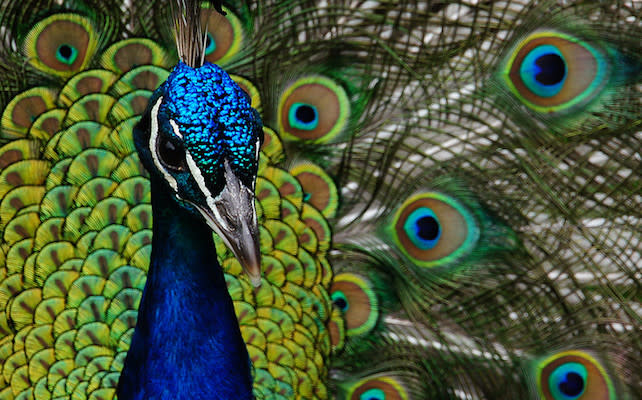Nature comes in a variety of striking colors, but all that beauty didn’t evolve for our enjoyment. Conspicuous colors tend to be signals, often helping animals woo mates or warn predators.
Yet the origins of these attention-grabbing colors are not clear. Did plants start making jazzy fruits and flowers before anyone on Earth could see color? Did that allow some animals to evolve color vision for foraging – and to eventually evolve dramatic colors of their own?
Or did color vision come first, with both plants and animals evolving vivid colors only after the emergence of animals who could see them?
Advertisement
Advertisement
In a new study, US researchers shed light on what they call an “explosion” of animal color signals over the past 100 million years – with novel insights about the timing and possible triggers of this evolutionary innovation.
“We wanted to know when bright coloration evolved and what was the purpose of that coloration. That’s largely why we pursued this study,” says co-author Zachary Emberts, an integrative biologist at Oklahoma State University.
Emberts and lead author John Wiens – an evolutionary ecologist at the University of Arizona – analyzed literature on color signals used by plants as well as animals.
Conspicuous colors in plants almost certainly evolved under selective pressure from animals, the researchers note, given color signals’ reliance on eyesight. Plants employ two main types of color signals: Colorful fruits attract fruit-eating animals to serve as seed dispersers, while flashy flowers lure pollinators.
Advertisement
Advertisement
Animals use color in many ways, including camouflage and heat regulation, but their more conspicuous hues tend to convey one of two basic messages: “check me out” or “leave me alone.”
Some animals use color signals to impress potential mates from their own species, while even more leverage their flamboyance for a strategy known as aposematism, in which conspicuous colors advertise an animal’s toxicity, tenacity, or other qualities to discourage troublemakers.
Based on their statistical analysis, Wiens and Emberts conclude color vision in animals came first, evolving more than 100 million years before plants began producing colorful fruits and flowers.
Research suggests color vision first appeared roughly 500 million years ago, apparently evolving independently in ancient arthropods and vertebrates.
Advertisement
Advertisement
More in Science
The first vertebrates to see in color likely lived in a marine habitat, Wiens and Emberts report, but it’s less clear where arthropods’ color vision arose.
It’s also unclear what evolutionary benefits color vision offered back then, before the advent of color signaling in plants or animals.
Sensing color could have helped animals visually scrutinize objects, nest sites, or food. Even before vivid fruits and flowers existed, color vision might have been useful for distinguishing items like green and brown leaves.
Regardless, it took the plant kingdom a while to capitalize. The first color-signaling fruits reportedly evolved around 300 million years ago, and eye-catching flower colors didn’t appear until about 200 million years ago.
Advertisement
Advertisement
Animals began using color signals even more recently, starting with aposematic warnings, according to Wiens and Emberts.

Their analysis suggests warning colors evolved about 150 million years ago, followed by sexual color signals, which only made their debut about 100 million years ago – some 400 million years after the advent of color vision.
Since then, however, animals’ color signals have struck an evolutionary chord.
“There has been a dramatic explosion of both warning and sexual color signals in the last 100 million years,” Wiens says.
Whatever factors eventually sparked the color-signaling explosion remain mysterious, but Wiens and Emberts identify three animal groups that likely fueled the trend. Ray-finned fish helped pioneer color signaling in marine habitats, while birds and lizards led the charge on land.
Advertisement
Advertisement
Aposematic colors and markings are an older – and more prevalent – form of color signaling than sexual signals.
“Warning signals are at least five times more widespread. That’s the overall pattern,” Wiens says.
Aside from evolving earlier, animal warning signals may also be more common than sexual signals simply because they’re practical for a wider range of species.
An animal doesn’t need to have color vision itself to scare predators with its vibrant hues – as long as the predator can see them. Some species with warning colors don’t even have well-developed eyes, the researchers note.
Sexual signals, on the other hand, require more advanced vision since senders and receivers are from the same species. That may be why these signals are generally limited to vertebrates and arthropods.
Advertisement
Advertisement
This study helps map out the evolutionary history of animals’ color vision and signaling, but we still have a lot to learn about these phenomena – including what drives variation in different animals’ color vision.
“In the future, it would be even more interesting to study what drives the ability of animals to see specific colors like red or blue,” Emberts says.
The study was published in Biological Reviews.
Related News
EMEA Tribune is not involved in this news article, it is taken from our partners and or from the News Agencies. Copyright and Credit go to the News Agencies, email news@emeatribune.com Follow our WhatsApp verified Channel





